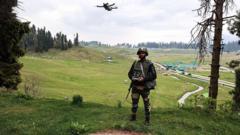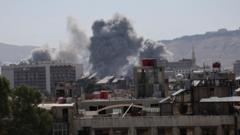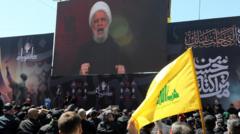The recent conflict between India and Pakistan marks a troubling shift to drone warfare among nuclear-armed states. As both nations share accusations of strikes and retaliation, experts warn of the growing implications these unmanned systems have on regional stability.
Unmanned Warfare: Rising Tensions as India and Pakistan Engage in Drone Conflict

Unmanned Warfare: Rising Tensions as India and Pakistan Engage in Drone Conflict
South Asia witnesses a perilous escalation in military strategy as India and Pakistan dabble in drone warfare, prompting international concerns over nuclear safety.
The landscape of military engagement between India and Pakistan has dramatically altered, with both nations entering what could be termed the first war fought primarily with drones. On Thursday, India accused Pakistan of launching a series of drones and missile attacks on its military installations in Indian-administered Kashmir, a claim that Pakistan firmly rejected. Instead, Islamabad announced it had intercepted and downed 25 Indian drones across several cities including Karachi and Lahore, escalating the cycle of retaliatory strikes.
Experts highlight this development as a distinctly perilous evolution in the longstanding Indo-Pak rivalry, showcasing not just traditional artillery exchanges but an emerging reliance on unmanned aerial technologies. "This new age of drone warfare introduces a level of stealth and deniability, fundamentally altering how military strategies are formulated in South Asia," observed Jahara Matisek, a professor affiliated with the US Naval War College. Washington, along with other global powers, has urged both sides to exercise restraint to prevent further escalation.
The bombardments have resulted in tragic civilian casualties, with reports indicating 36 fatalities and numerous injuries on the Pakistani side due to Indian strikes. Conversely, India has claimed a similar number of civilian deaths due to retaliatory fire from Pakistan. Each nation maintains its attacks are justified acts of response—India cites a recent militant attack against tourists in Pahalgam, a responsibility Pakistan denies.
The implementation of drones has become a key feature in this unfolding situation. India’s arsenal comprises sophisticated UAVs, such as the Israeli-produced Harop drone, positioned as precision weapons capable of executing intricate operations. The country is in the process of bolstering its drone capabilities through acquisitions, including a substantial $4 billion deal for Predator drones from the United States.
Pakistan's drone inventory is equally diverse, featuring systems sourced from Turkey and China, as well as indigenous models. This arms race is underscored by each nation’s efforts to enhance their military capacities through cutting-edge drone technology, transformed over the years into essential components of modern warfare.
As both military forces engage in this new paradigm characterized by unmanned systems, analysts stress that the mere presence of drones does not entirely equate to an escalation similar to that seen in the Ukraine-Russia conflict. While currently leveraged for targeted strikes, experts warn that the situation could evolve, potentially leading to broader military confrontations.
Amid the drone exchanges, the potential for miscalculations grows. Manoj Joshi, an Indian defense analyst, cautions that these actions, while seemingly restrained, carry the potential to spark a larger conflict. Meanwhile, Ejaz Haider, a defense analyst from Lahore, describes the continual escalation as tactical rather than strategic—a response to provocations rather than a proclamation of outright war.
In this tenuous climate, the implications of drone warfare in the India-Pakistan relationship remain largely unpredictable. Experts underscore that the integration of drones creates new avenues for both surveillance and targeted action, but with these advances come new risks of escalation, as each maneuver could become a flashpoint between two nuclear-armed nations, potentially destabilizing the fragile equilibrium in the region. As both countries refine their military strategies focused on unmanned technologies, the world watches closely for any signs of irremediable conflict.





















